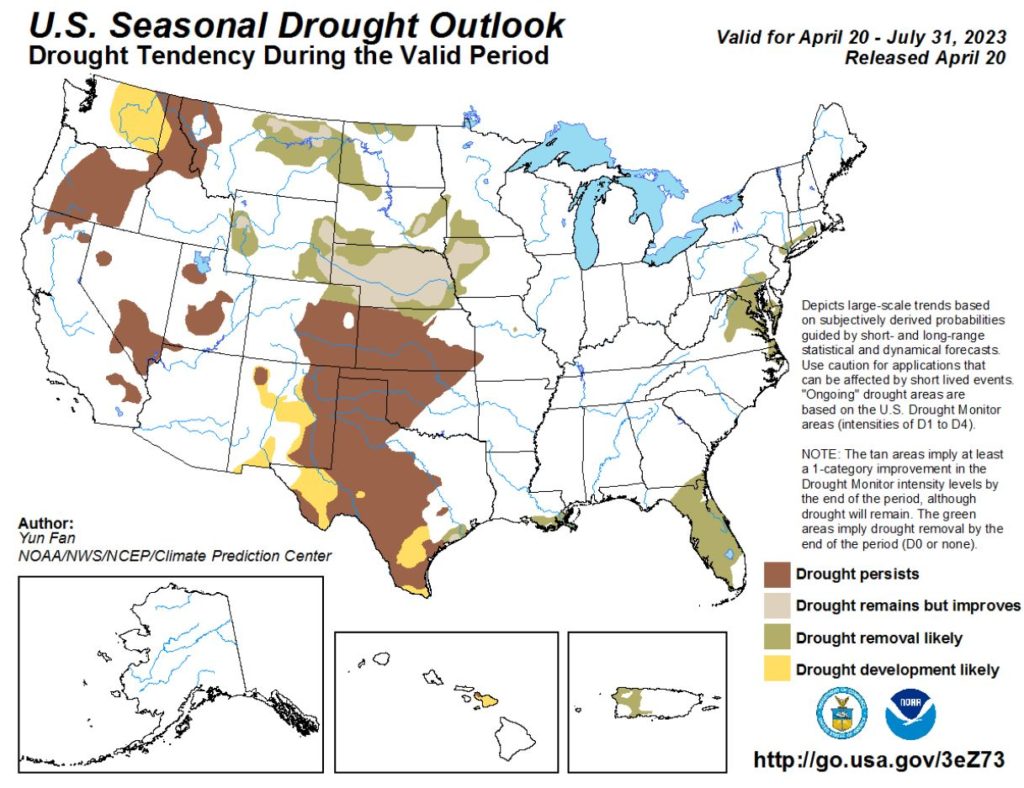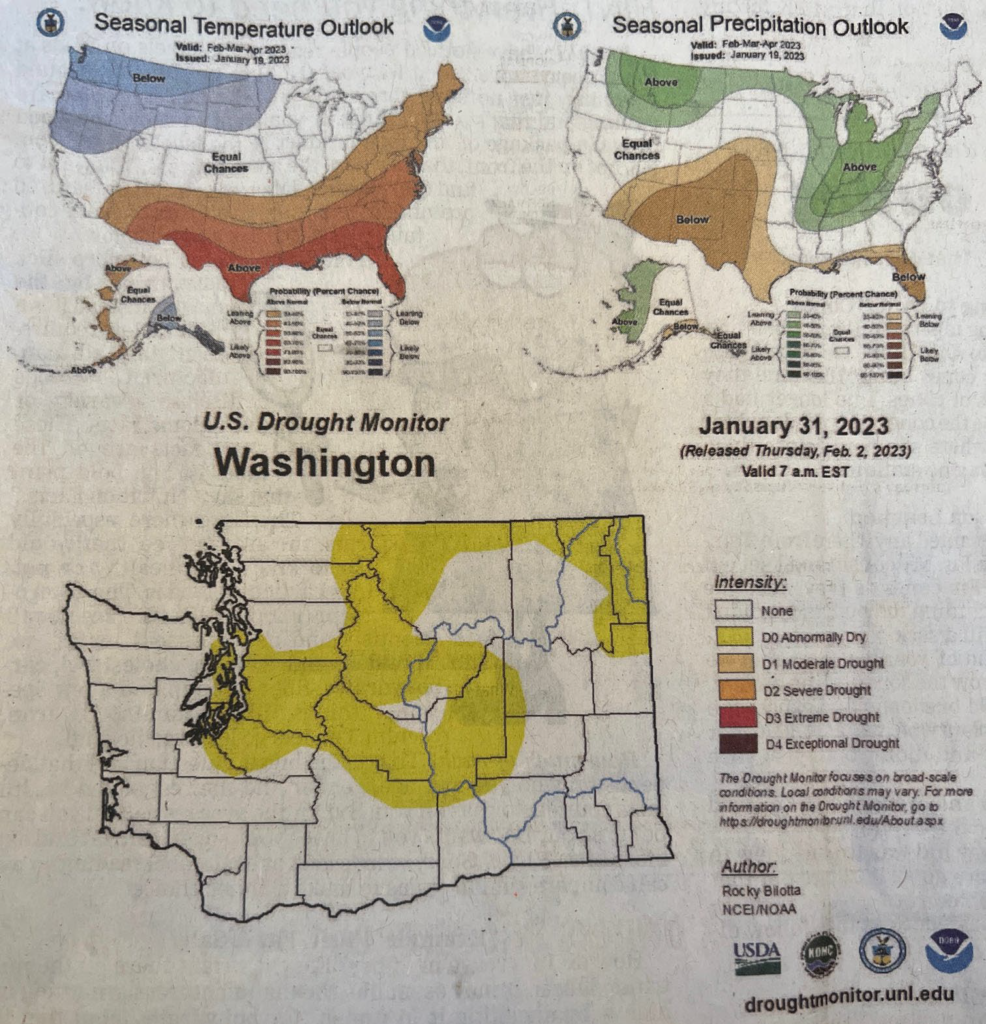YBSA Monthly Report May 2023
Storage: Total storage in the 5 reservoirs is at 86% capacity which is at average for this time of year. Reservoir content is at 920,000 acre/feet. Inflow to the 5 reservoirs is at 77% of average and release is at 93%. Unregulated flow in the Yakima River at Parker is at 69% and regulated flow is at 50% of average.
Pulse flow from Lake Cle Elum will release about 10,000 acre/feet to benefit seasonal migration of salmon smolts. There is no report on the amount of cubic feet per second of water flowing in the Cle Elum River below the dam.
Salmon Runs: Smaller spring run prompts fishing closure for Yakamas, other tribes on Columbia River as reported in the Yakima Herald, May 21, 2023. “Spring tribal fisheries were closed Thursday on the Columbia River after it was determined that fewer fish are returning this spring than initially predicted.” Click Here for full article
Irrigation: The diversion of water from the Yakima River is providing 100% of the water necessary for the agriculture industry in the Yakima Basin.
YBSA Monthly Report April 2023
Storage: Volume of water in the 5 reservoirs is at 56% capacity. The amount in storage now is 250,000 acre/feet less than last year and 200,000 acre/feet less than average. Spring snow melt and runoff will continue through the month of May which may prolong the content of stored water and may increase instream flow in the lower Yakima River. Snow water content is at 100% which means the amount of water depends on the size of the snow pack.
YBSA: Tom Carpenter, Jr., one of the most important leaders in the Yakima Basin, worked to develop an annual amount of water to be made available for agriculture and increasing and maintaining instream flow in the Yakima River for salmonoids. The Carpenter family was one of the early farmers to introduce hops to the Yakima Basin. Two decades ago, the Basin was in need of water and many farmers had to drill wells to maintain their crops. Tom’s goal was to provide enough water each year to eliminate the possibility of droughts. Now that Tom has passed we still have to continue with the work of solving the water needs in the Yakima Basin that he was so involved with.
News Stories: In the Yakima Herald Republic article, Toppenish Creek fish project gets $16.M federal boost from April 28, 2023, Phil Ferolito reported, “Two diversion dams and a nonfunctional fish screen will be replaced with fish passage structure on the Lower Toppenish Creek to provide a better migration path for Pacific lamprey and steelhead.” Click Here for full article.
In the April 25th edition of the Walla Walla Union Bulletin the article, Drought likely to develop in Washington after our cool, dry spring “Storage levels in the Yakima, Columbia and Upper Snake River basins were in decent, if not great, shape as of April 20, Bond said. There may be some restrictions on junior water rights holders in the Yakima Basin this summer, he said. Click Here for full article.

YBSA Monthly Report February 2023
Storage: Storage is at 83% of average. Reservoir storage is at 49% of average. At this time, water in the 5 reservoirs is currently 518,000 acre/feet, last year it was 772,000 acre/feet, and the average is 578,000 acre/feet over the last decade. National Resources Conservation Service snotel (snowpack telemetry) SWE (snow water equivalent) is at 96% of average in the upper basin and 83% in the Naches Basin.
Environmental Conditions: As reported in the Northern Kittitas County Tribune Feb 16th edition:
The U.S. Drought Monitor shows adversely dry conditions in Kittitas, Yakima, and Benton Counties. The Seasonal Temperature Outlook is lower than average. And the Seasonal Precipitation Outlook is above average. (See charts below).

YBSA Monthly Report January 2023
Storage: The amount of stored water in the 5 reservoirs is at 47% of average. The amount of water at this time is way below last year and below average over the last decade. Mountain rainfall from October through January at the 5 reservoirs is 30% of average.
Natural Resources Conservation Service Snow Telemetry (NRCS SNOTAL): The snow water equivalent for the upper basin is at 94% and 85% at the Naches Basin.
Forecast: The forecast through late January shows a probability for above normal temperatures and above normal precipitation. The U.S. drought monitor indicates a continuation of the drought. For addition information Click Here.
Fish Habitat & Passage Projects: Projects for fish habitat and passage continue but do not include additional increase for instream flow.
YBSA Monthly Report December 2022
Storage: The volume of water in all 5 reservoirs is at 42% of average (1991-2020). The amount stored at this point in time is way below the amount stored last year. Snowpack (Snow Water Equivalent) is less than 100% in the Naches corridor and more than 110% in the upper basin.
Fish Passage: The Yakama Nation awarded about $4.8 million in grants to improve fish passage in the Yakima River Basin. Improvements in the Yakima River should improve the number of resident fish and increase the salmonoids which return up the river.
2022: It was an unusual year. Climate change affected our basin. The agricultural industry had delays and a smaller yield. Water for agriculture and fish was adequate, but more water in the Yakima River would have created a larger number of returning salmonoids.
2023: The Yakima Basin Storage Alliance wishes everyone a happy and prosperous New Year. Continued cooperation between all stakeholders will ensure successes in providing water for instream flow (fish) and out of stream use (agriculture).
YBSA Monthly Report November 2022
Storage: Current reservoir storage is at 39%. It is less than last year at this time and is at average compared to the last several years.
River flow: The flow in the Yakima River continues to be low. Irrigation season is over so return flow to the lower Yakima River does not help increase the volume.
Meeting with Bureau of Reclamation (BOR): Five members of the Yakima Basin Storage Alliance (YBSA) met with Tom Tebb, Ecology, Wendy Christensen, Yakima BOR, and Jennifer Karrington, Northwest Regional Director from BOR Idaho, who attended through Zoom. Charlie de La Chapelle presented a detailed report on the progress made over the years in the Yakima River Basin on water issues. He emphasized the need for an annual supply of water for agriculture and fish. Improvements have been made, but there needs to be a better way to provide additional water to the basin including the use of the Columbia River. Bob Hall pointed out how important water is to the area since the economy is based on how our supply of water supports businesses, industries, and families.
YBSA applauds BOR for their efforts to solve the needs of the Yakima River Basin. Conservation, habitat improvements, and fish passage including the catch and haul of salmonoids have greatly enhanced the Yakima Basin. The Yakima Basin still needs additional water to ensure the Basin’s way of life.
YBSA Monthly Report October 2022
Storage: The five reservoirs are at 33% of capacity which is a little more than the stored amount from last year at the same time. Lake Cle Elum, the largest reservoir, is at 29%. Inflow of water to the reservoirs is at 423 cubic feet per second (cfs) and releases are at 655 cfs.
River Flow: The flow in the lower Yakima River continues to be low and water temperatures during the summer were hazardous to the survival of salmonoids. Part of the Yakima Basin Integrated Plan (YBIP) is to increase the survival and population of returning salmonoids in the Yakima River. Their approach has been holy inadequate. See the article: Rising temperatures will shift timing of water availability, amplifying vulnerabilities in Columbia River Basin over next 20 years.
Fish Recovery: Grant awards were made by a state board for salmon recovery. Nearly $76 million was awarded including funds for the Yakima River Basin. The article about this award can be found in the September 29, 2022 Northern Kittitas County Tribune. Federal officials visited Rimrock Lake to announce $400K boost for a fish project. The article about this award can be found by clicking on the Yakima Herald link.
All the proposed projects would be more successful with additional water in the Yakima Basin. Don’t forget all the benefits that could be achieved with additional water from the Columbia River. Remember your vote is very important!